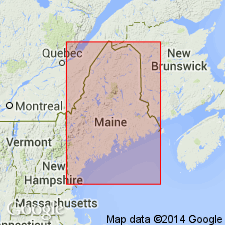
- Usage in publication:
-
- Cookson Formation
- Modifications:
-
- Named
- Dominant lithology:
-
- Slate
- Phyllite
- Quartzite
- AAPG geologic province:
-
- New England province
Summary:
The Cookson Formation is here named in the St. David Dome in the Piskahegan-Rolling Dam area of New Brunswick and to the southwest in Maine. Rocks of the Cookson were previously named the Dennis Formation by MacKenzie (1940), but that name is not retained because the quartzitic, intensely metamorphosed Dennis section is not typical of the unit. The Cookson has also been mapped as part of the "Dark Argillite Division of the Charlotte Group" of MacKenzie and Alcock (1960). The Cookson Formation consists of thinly laminated black slate, silty slate, phyllite with minor interbedded quartzite, and their metamorphic equivalents. Well developed slaty cleavage and spotted slates are typical. Separated from the overlying Oak Bay Formation by an erosional unconformity. Age is Early Ordovician based on graptolites.
Source: GNU records (USGS DDS-6; Reston GNULEX).
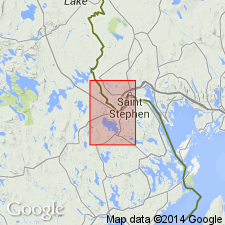
- Usage in publication:
-
- Cookson Formation
- Modifications:
-
- Revised
- AAPG geologic province:
-
- New England province
Summary:
Cookson Formation is here revised and stratigraphically restricted in eastern ME. All of the rocks previously mapped as Cookson Formation in the study area now compose the [informally] named Wapsaconhagan Brook Group. Informal subdivisions of the Cookson (Ruitenberg and Ludman, 1978; Ludman, 1985) are considered worthy of formation rank. The name Cookson in ME is now applied only to those rocks that correspond to Ruitenberg's (1967) original description of the unit at its type locality in CAN. These crop out at the top of the Wapsaconhagan Brook between the cobble conglomerates of the unconformably overlying Oak Bay Formation and the successively underlying Woodland, Kendall Mountain, and Pocomoonshine Lake Formations (all new [informal] names). In the St. Croix River area, a sequence of pillow basalts, massive basalts, cherts, and coticule rocks interbedded with black, sooty pelites that occur at the top of the Cookson are informally named the Calais member. It does not occur at the Cookson type locality. Most of the rocks are rusty weathering, highly carbonaceous black slate and phyllite with very minor beds of quartzwacke. Minimum thickness of the restricted Cookson is estimated at 1000 m. Cookson probably correlates with Ship Cove Formation of the St. John Group in New Brunswick. Identical in lithology and age to the Benton Slate of the Miramichi anticlinorium. Age is earliest Ordovician (Tremadocian).
Source: GNU records (USGS DDS-6; Reston GNULEX).
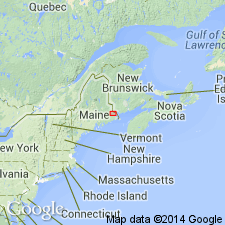
- Usage in publication:
-
- Cookson Group
- Modifications:
-
- Revised
- AAPG geologic province:
-
- New England province
Summary:
Cookson Formation here elevated to group rank in the St. Croix belt of southeastern ME, and southwestern NB. Unit is subdivided into 4 formally named formations: (ascending) Pocomoonshine Lake, Kendall Mountain, Woodland, (all Late Cambrian) and Calais (Early Ordovician) Formations. Cookson is in tectonic contact on the west with the Flume Ridge and Digdeguash Formations of the Fredericton trough. Base of the group has not been observed and what lies beneath it is unknown. [It is inferred that the Wapsaconhagan Brook Group, introduced by Ludman in a 1986 open-file report, is here abandoned as the Cookson Group replaces the Wapsaconhagan Brook in its entirety. Calais Formation of this report is equivalent to Ludman and Hill's (1986) restricted Cookson Formation]
Source: GNU records (USGS DDS-6; Reston GNULEX).
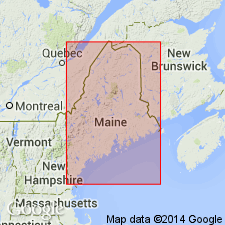
- Usage in publication:
-
- Cookson Group
- Modifications:
-
- Revised
- Areal extent
- Age modified
- AAPG geologic province:
-
- New England province
Summary:
Stratigraphic order of the formations within the Cookson Group is here revised based on new fossil evidence. Ascending, these units are Calais, Woodland, Pocomoonshine Lake, and Kendall Mountain Formations. The Digdeguash, previously considered Silurian, is here included in the Cookson as an equivalent of the Woodland and Pocomoonshine Lake Formations. Kendall Mountain, once thought to be Cambrian and placed at the base of the Cookson, contains Caradocian graptolites and is now considered the youngest preserved part of the Group. Calais Formation previously dated as Arenigian. Therefore, Cookson ranges from Early to Middle [Late] Ordovician. [Author equates Caradocian with Middle Ordovician. According to Elsevier, 1987, Caradocian is Late Ordovician.]
Source: GNU records (USGS DDS-6; Reston GNULEX).
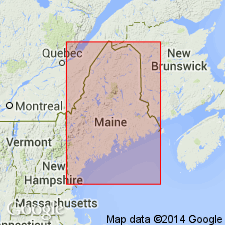
- Usage in publication:
-
- Cookson Group
- Modifications:
-
- Revised
- Age modified
- AAPG geologic province:
-
- New England province
Summary:
Author disagrees, in part, with revisions of Cookson proposed by Fyffe and Riva (1990). Though he agrees that fossil evidence requires inversion of the stratigraphic sequence, he states that the Pocomoonshine Lake and Digdeguash formations are more likely a part of the Fredericton belt rather than of the St. Croix terrane and therefore are not part of the Cookson Group. Interpretation is based on lithologic and structural evidence. As here revised the Late Cambrian(?) to Middle [Late] Ordovician Cookson comprises (ascending) Calais, Woodland, and Kendall Mountain Formations. Cookson Group tectonically underlies (ascending) Pocomoonshine Lake, Digdeguash, and Flume Ridge Formations.
Source: GNU records (USGS DDS-6; Reston GNULEX).
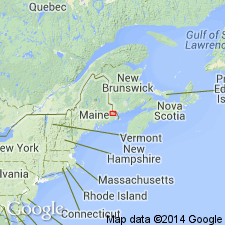
- Usage in publication:
-
- Cookson Group
- Modifications:
-
- Age modified
- AAPG geologic province:
-
- New England province
Summary:
Pocomoonshine Gabbro-Diorite intrudes the Pocomoonshine Lake, Digdeguash, and Flume Ridge Formations in the Fredericton belt and cuts the Kendall Mountain and Woodland Formations of the Cookson Group in the St. Croix belt. The pluton was emplaced during two separate episodes during the Silurian Period. 40Ar/39Ar hornblende ages form the northern mafic portion indicate crystallization at 422.7+/-3.0 Ma. Muscovite plateau age of 414.2+/-3.2 Ma is minimum age for central and southern dioritic portions of the pluton. Therefore, deposition of the Pocomoonshine Lake, Digdeguash, and Flume Ridge Formations is constrained to Late Caradocian (early Late Ordovician) through Early Silurian. The Cookson Group is interpreted as Late Cambrian(?) through Late Ordovician. According to authors, a major episode of folding and regional metamorphism must have taken place during the Silurian. Melding of the Fredericton, St. Croix, and Coastal Volcanic belts into a single block must have occurred by the Silurian. Accretion of this composite block to ancestral North America, then, was probably responsible for the Acadian Orogeny in northern New England.
Source: GNU records (USGS DDS-6; Reston GNULEX).
For more information, please contact Nancy Stamm, Geologic Names Committee Secretary.
Asterisk (*) indicates published by U.S. Geological Survey authors.
"No current usage" (†) implies that a name has been abandoned or has fallen into disuse. Former usage and, if known, replacement name given in parentheses ( ).
Slash (/) indicates name conflicts with nomenclatural guidelines (CSN, 1933; ACSN, 1961, 1970; NACSN, 1983, 2005, 2021). May be explained within brackets ([ ]).

